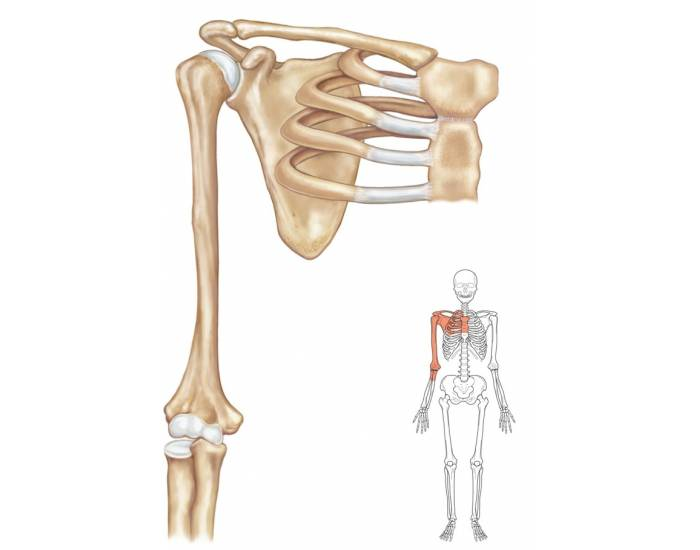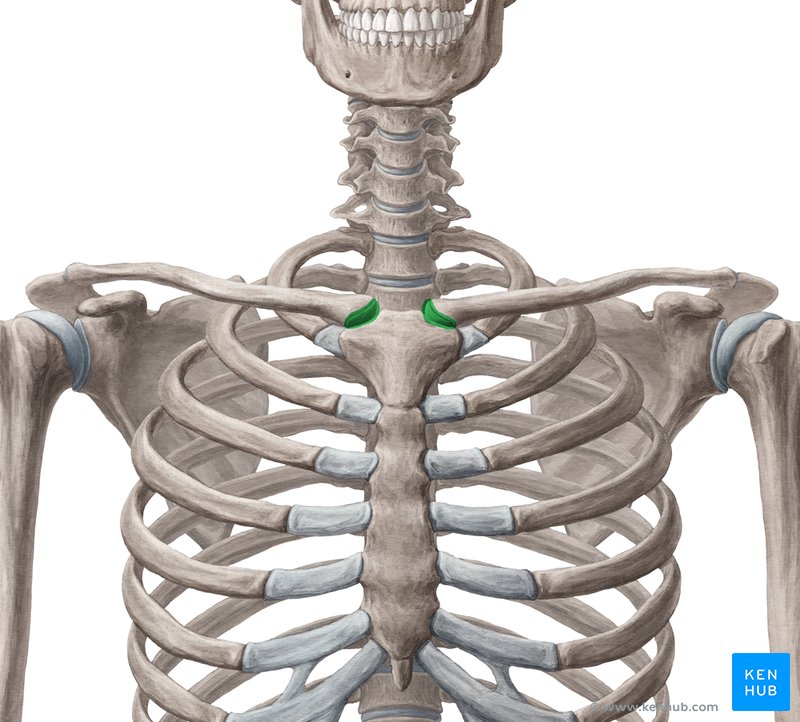Upper Extremity Anatomy – Part 1 (Bones, Joints, Muscles, Neurovascular & Surface Anatomy)
1/126
Earn XP
Description and Tags
A comprehensive set of question-and-answer flashcards covering bones, joints, ligaments, muscles, innervation, vascular supply, surface anatomy, pathologies, and movements of the upper extremity as presented in Module IV – Upper Extremity Anatomy (Part 1).
Name | Mastery | Learn | Test | Matching | Spaced |
|---|
No study sessions yet.
127 Terms
Which bones make up the pectoral (shoulder) girdle?
Scapulae, clavicles, and the manubrium of the sternum

What is the only true bony articulation between the upper limb and axial skeleton?
The sternoclavicular (SC) joint

Name the four segments of the upper limb.
Shoulder, arm (brachium), forearm (antebrachium), and hand (manus)
Which bone transmits shock from the upper limb to axial skeleton and is the most commonly fractured in young individuals due to a fall on the shoulder?
Clavicle
Name the articulations of the shoulder girdle.
sternoclavicular joint
acromioclavicular joint
scapulothoracic joint
glenohumeral joint
Name the carpal bones from lateral (radial) to medial in the proximal row.
Scaphoid, lunate, triquetrum, pisiform
Name the carpal bones of the distal row from lateral (radial) to medial.
Trapezium, trapezoid, capitate, hamate
Which carpal bone is most commonly fractured and why is avascular necrosis a concern?
Scaphoid; its proximal fragment can lose blood supply because the nutrient artery enters distally
What two ligaments primarily reinforce the acromioclavicular (AC) joint?
Acromioclavicular ligament and coracoclavicular ligament
AC joint function
Gliding movement; allows ability to raise arm above head.
Which shoulder joint is described as a ball-and-socket synovial joint with three degrees of freedom?
Glenohumeral joint
Name the three glenohumeral ligaments and state their general function.
Superior, middle, and inferior glenohumeral ligaments; they strengthen the anterior capsule of the shoulder
Which ligament forms the coraco-acromial arch and prevents superior displacement of the humeral head?
Coraco-acromial ligament
Which bursae are commonly involved in shoulder impingement pain during early abduction?
Subacromial bursa (primary) and subdeltoid bursa
The head of the radius articulates with which part of the humerus?
Capitulum
The trochlea of the humerus articulates with what part of the ulna?
Trochlear notch
Name the two collateral ligaments of the elbow and their primary attachments.
Ulnar (medial) collateral ligament – medial epicondyle to coronoid process & olecranon
Radial (lateral) collateral ligament – lateral epicondyle to annular ligament of radius
Which elbow pathology is also called "lateral epicondylitis" and results from repetitive wrist extension?
Tennis elbow
Describe a Colles fracture.
A complete fracture of the distal 2 cm of the radius with posterior displacement, producing a ‘dinner-fork’ deformity; common after a fall on an outstretched hand in adults >50 y/o
What type of synovial joint is the proximal radio-ulnar joint, and what structure holds the radial head in place?
Pivot joint; annular ligament
What nerves innervate the proximal radioulnar joint?
musculocutaneous, median and radial nerves
Which nerve can be injured in an anterior shoulder dislocation?
Axillary nerve
What are the origin and insertion of pectoralis major m.?
Origin- anterior border of the medial half of clavicle, anterior surface of the sternum, superior 6 costal cartilages
Insertion- humerus
What is the innervation of pectoralis major?
Medial and lateral pectoral nerves (C5–T1)
State the main actions of pectoralis major.
Flexes, adducts, and medially rotates the humerus; draws scapula anteriorly and inferiorly
Which muscle protracts and stabilizes the scapula and is innervated by the long thoracic nerve?
Serratus anterior
Damage to which nerve causes winged scapula, and which muscle is affected?
Long thoracic nerve; serratus anterior
What is the primary abductor of the arm beyond the first 15 degrees?
Deltoid muscle
Which muscle initiates the first 15° of shoulder abduction?
Supraspinatus
Name the four rotator cuff muscles.
Supraspinatus, infraspinatus, teres minor, subscapularis
Which rotator cuff tendon is most commonly torn?
Supraspinatus tendon
The latissimus dorsi is innervated by which nerve and performs which main actions?
Thoracodorsal nerve (C6–C8); extends, adducts, and medially rotates the humerus; pulls body toward arms in climbing
Which muscle elevates the scapula and is innervated by C3-C5 nerves?
Levator scapulae
What are the actions of trapezius on the scapula?
Elevation (upper fibers), retraction, rotation, and depression (lower fibers)
Which nerve innervates trapezius?
Accessory nerve (CN XI) with C3-C4 proprioceptive fibers
State the origin and insertion of the teres major.
Origin: posterior inferior angle of scapula; Insertion: medial lip of intertubercular sulcus of humerus
Which nerve innervates teres minor?
Axillary nerve
Give the main action of infraspinatus.
Lateral (external) rotation of the humerus and stabilization of the shoulder joint
Which artery is the direct continuation of the subclavian artery at the lateral border of the first rib?
Axillary artery
At the inferior border of teres major, the axillary artery becomes which vessel?
Brachial artery
The superficial palmar arch is mainly supplied by which artery?
Ulnar artery
Which veins form the median cubital vein commonly used for venipuncture?
Cephalic vein (lateral) and basilic vein (medial)
What movement combinations raise the arm overhead?
Sequential action of supraspinatus (initiation), deltoid (abduction), and serratus anterior plus trapezius (scapular upward rotation)
Name the prime elevators of the scapula.
Upper (cervical) portion of trapezius, levator scapulae, rhomboids
Which muscles are the main protractors (abductors) of the scapula?
Serratus anterior and pectoralis minor
Identify the nerve roots of the musculocutaneous, median, ulnar, and radial nerves.
Musculocutaneous C5–C7, Median C5–T1, Ulnar C8–T1, Radial C5–T1
What type of joint is the elbow and which actions does it allow?
Hinge synovial joint; flexion and extension (plus pronation/supination at the proximal radio-ulnar components)
Which bursa is commonly inflamed from repeated pressure on the posterior elbow?
Subcutaneous olecranon bursa (olecranon bursitis)
Why are lunate dislocations clinically significant?
They can compress the median nerve in the carpal tunnel and may lead to avascular necrosis of the lunate
Which carpal bone’s hook may fracture in golfers and why can it lead to nonunion?
Hamate; muscle traction on the hook may prevent union
How many metacarpals and phalanges are in one hand?
5 metacarpals; 14 phalanges (3 per finger, 2 in the thumb)
What movements occur at the metacarpophalangeal (MCP) joints?
Flexion, extension, abduction, adduction, and circumduction
Which ligaments reinforce the MCP joints laterally?
Collateral ligaments
Differentiate PIP and DIP joints.
PIP (proximal interphalangeal) joints are between proximal and middle phalanges; DIP (distal interphalangeal) joints are between middle and distal phalanges
Which nerve supplies the serratus anterior and what is its root value?
Long thoracic nerve (C5-C7 roots)
Name the main actions of rhomboid major.
Retracts (adducts) scapula, rotates scapula to depress glenoid cavity, and fixes scapula to thoracic wall
Where does the biceps brachii long head tendon lie in the humerus?
In the intertubercular (bicipital) groove
Which groove on the posterior humerus houses the radial nerve?
Radial (spiral) groove
Identify the anatomical landmark on the humerus prone to surgical neck fractures.
The surgical neck just distal to the tubercles
Which bone is lateral in the forearm and articulates directly with the carpal bones?
Radius
Which distal forearm styloid process is larger and more distal?
Radial styloid process
What nerve innervates pectoralis minor?
Medial pectoral nerve (C8–T1)
List the actions of the deltoid’s three parts.
Clavicular: flexes & medially rotates arm; Acromial: abducts arm; Spinal: extends & laterally rotates arm
Which muscle forms the posterior wall of the axilla and assists in arm extension and adduction?
Latissimus dorsi
What is the primary function of the teres minor within the rotator cuff?
Lateral rotation of the arm and stabilization of the humeral head
Which ligament attaches the clavicle to the first rib and limits elevation of the pectoral girdle?
Costoclavicular ligament
Define ‘shoulder separation’.
An acromioclavicular (AC) joint injury due to inferior displacement of the shoulder, classified in six types
What muscle is tested by asking a patient to abduct their arm against resistance starting at 15°?
Deltoid (specifically its acromial part)
Which artery runs with the radial nerve in the radial groove of the humerus?
Profunda brachii (deep brachial) artery
Name the bursae located under the coracoid process.
Subcoracoid bursa
What forms the coraco-acromial arch?
Coracoid process, acromion, and coraco-acromial ligament
Which joint has an articular disc binding the distal ends of the radius and ulna?
Distal radio-ulnar joint
What is the nerve supply to the glenohumeral joint?
Suprascapular, axillary, and lateral pectoral nerves
Which muscle retracts, elevates, and rotates the scapula and is innervated by the dorsal scapular nerve?
Rhomboid minor (and rhomboid major)
Identify the contents of the cervicoaxillary canal protected by the clavicle.
The brachial plexus and subclavian/axillary vessels
Which muscle depresses the clavicle and steadies it during upper-limb movements?
Subclavius
State the main actions possible at the glenohumeral joint.
Flexion, extension, abduction, adduction, medial rotation, lateral rotation, and circumduction
Which artery supplies the head of the humerus via the posterior circumflex humeral branch?
Axillary artery (via posterior circumflex humeral artery)
Name the ligament injured in a ‘nursemaid’s elbow’ (radial head subluxation).
Annular ligament of the radius
What forms the anatomical snuff box boundaries?
Tendons of abductor pollicis longus & extensor pollicis brevis (lateral) and extensor pollicis longus (medial)
Which carpal bones articulate with the distal radius?
Scaphoid and lunate
Describe the blood supply pattern that predisposes the lunate to avascular necrosis.
Vessels enter through anterior and posterior radiocarpal ligaments; dislocation can disrupt both supplies
Which muscle fixes the scapula to the thoracic wall and rotates it to depress the glenoid cavity?
Rhomboid major
What structure receives the olecranon during elbow extension?
Olecranon fossa of the humerus
Name the three major branches of the brachial artery in the arm.
Profunda brachii artery, superior ulnar collateral artery, inferior ulnar collateral artery
Which muscle’s tendon runs in the bicipital groove and may cause shoulder pain if inflamed?
Long head of biceps brachii
Which parts of the deltoid accomplish arm extension?
Spinal (posterior) fibers
What nerve root level is tested by the biceps tendon reflex?
C5–C6 (mainly C5)
Which muscle is the prime mover for forearm pronation at the proximal radio-ulnar joint?
Pronator teres (assisted by pronator quadratus)
Give the sequence of lymph drainage from the lateral hand to the central venous system.
Superficial lymphatics → lateral (humeral) axillary nodes → central axillary nodes → apical axillary nodes → subclavian trunk → right lymphatic duct or thoracic duct → venous angle
Which muscle group provides inferior rotation of the scapula?
Pectoralis minor and rhomboids
Define ‘scapulothoracic joint’.
Physiologic (not true synovial) articulation between the scapula and the thoracic cage, allowing gliding movements during shoulder motion
Which collateral ligament of the elbow blends with the annular ligament?
Radial (lateral) collateral ligament
Where is the subcutaneous olecranon bursa located?
Between the skin and the olecranon process of the ulna
Name the muscle innervated by the upper and lower subscapular nerves.
Subscapularis
Which nerve innervates the skin over the deltoid "regimental badge" area?
Superior lateral cutaneous nerve of the arm (branch of the axillary nerve)
What forms the floor of the anatomical snuff box and which artery passes through it?
Scaphoid and trapezium bones; radial artery
Which ligament limits upward displacement of the clavicle at the SC joint?
Costoclavicular ligament
Identify the joint type and movements of the AC joint.
Plane (gliding) synovial joint; permits gliding and rotational movements of the acromion on the clavicle
Which movements occur at the distal radio-ulnar joint?
Pronation and supination (rotation of the distal radius around the ulna)